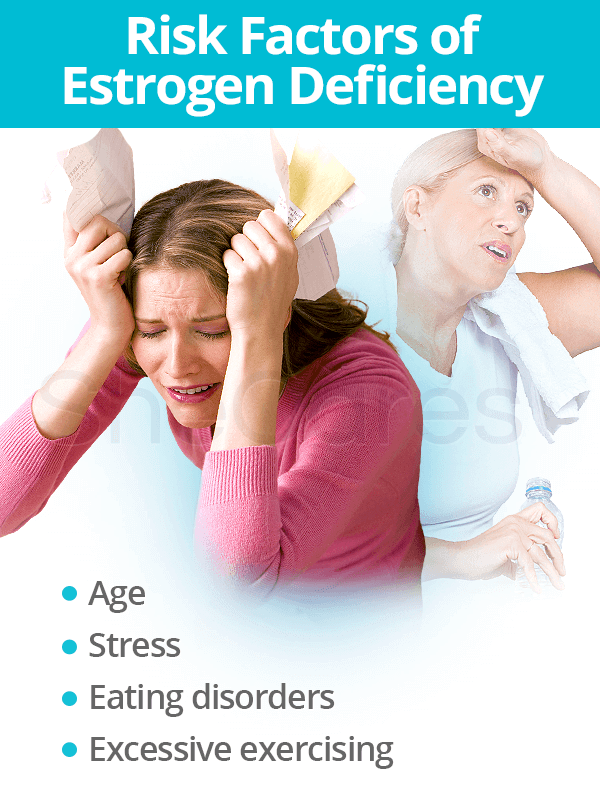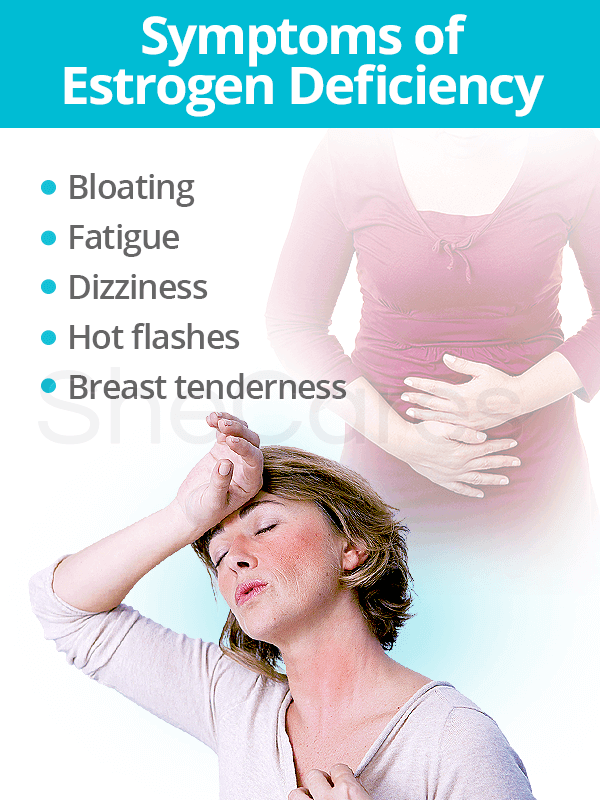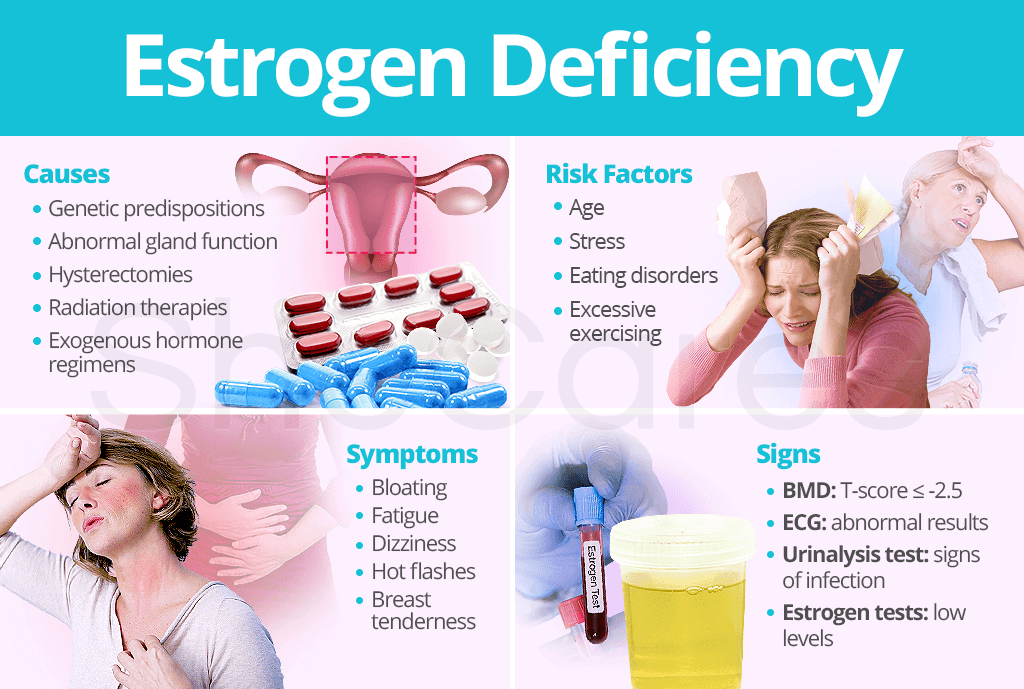There are periods in a woman's reproductive life in which her estrogen levels fluctuate from high to low, provoking a variety of temporary symptoms, including nausea, headaches, memory lapses, hot flashes, and more. However, when there are constantly or permanently decreased estrogen levels, more problematic conditions can develop.
Read on to learn more about the causes, risk factors, signs, and symptoms of estrogen deficiency to better understand how to redirect endocrine system functions back to normal.
What Is Estrogen Deficiency?

Estrogen deficiency - or hypoestrogenism – is a consistent lack or decreased levels of estrogen that has adverse effects on the female body.
For all intents and purposes, an estrogen deficiency is distinct from temporary low estrogen levels, which occur when estrogen levels are periodically below normal, such as the beginning of each menstrual cycle. An estrogen deficiency is mid- to long-term and continual.
Causes of Estrogen Deficiency

A permanent state of low estrogen levels - despite the hormone's regular fluctuation - is often caused by prolonged exposure to a certain stimulus.
Some principal causes that can provoke an estrogen deficiency include genetic predispositions, abnormal gland function, hysterectomies, radiation therapies, and exogenous hormone regimens.
Genetic predispositions
Some congenital conditions prohibit the body from producing or using estrogens. For example, an aromatase deficiency causes there to be permanently reduced levels of estrogen in light of increased testosterone.
With estrogen resistance, or estrogen insensitivity syndrome, estrogen receptors are unable to respond to the hormone's biological effects. Furthermore, estrogen deficiency can be caused by a neurogenetic disorder known as Turner syndrome.
Abnormal gland function
Hyperthyroidism can offset hormones responsible for triggering monthly ovulation or induce amenorrhea, which is an absence of menstrual cycles.
Moreover, hypopituitarism, a loss of pituitary gland hormone production, can lead to an estrogen deficiency as it helps control the secretion of sex hormones like estrogen. Miscommunication between the pituitary gland and ovaries leads to inadequate amounts of estrogen being produced.
Hysterectomies
There are several types of hysterectomies in which part or all of the reproductive system is taken out. In general, removing the ovaries generates an estrogen deficiency since they produce the majority of a woman's estrogen supply.
Surgical removal of the uterus alone does not invoke a state of estrogen deficiency immediately, but it was found that women develop deficiencies within six months to two years afterwards due to reduced blood flow to the ovaries.
Radiation therapies
Both chemotherapy and pelvic radiation therapy often affect ovarian function and hormonal levels in a woman's body, causing an estrogen deficiency.
Depending on a woman's age and dose of radiation, loss of ovarian function can occur as soon as two to three weeks into radiation treatment. This loss of ovarian function may be temporary or permanent.
Certain medications
Moreover, the consumption of exogenous hormones has been linked to the presence of an estrogen deficient state in women. These drugs - such as rifampicin, barbiturates, warfarin, primidone, carbamazepine, griseofulvin, and phenytoin - enhance estrogen's metabolism in the liver.
Recall that the liver is the organ responsible for converting estrogen to inactive metabolites to later be eliminated through the bowels. Therefore, with the metabolism process improved, estrogen is eliminated quicker.
Risk Factors of Estrogen Deficiency

Additionally, risk factors are characteristics that serve as potential reasons for women to have an estrogen deficiency. There are a variety of risk factors that make women more susceptible to this hormonal imbalance.
- Health risk factors. Women who fall under the following category may possess a heightened risk of having an estrogen deficiency.
Age. As women begin to transition into menopause, the ovaries will steadily produce less and less estrogen.
- Behavioral risk factors. More research is emerging that links estrogen deficiency to behavior factors, including:
- Eating disorders. Extreme dieting and anorexia nervosa can prompt a halt in estrogen production by leading to amenorrhea and further medical conditions.
- Excessive exercising. Exercise-induced amenorrhea can lead to an unhealthy drop in weight, and with insufficient body fat, the body will temporarily detain estrogen production.
- Stress. When hypothalamic function is interrupted by too much stress, endocrine system activities are disrupted, which can cause an estrogen deficiency.
Estrogen Deficiency Symptoms
Symptoms of estrogen deficiency are like those of low estrogen levels. However, these symptoms are normally continuous and can develop into complications if left unattended. Common estrogen deficiency symptoms include:

- Headaches and migraines
- Breast tenderness
- Hot flashes and night sweats
- Menstrual irregularities
- Bloating
- Insomnia
- Dizziness
- Fatigue
- Mood swings
- Mental fogginess
- Weight gain
- And more
Complications of Estrogen Deficiency
A constant and cumulative buildup of the aforementioned symptoms can manifest into major medical concerns. Critical complications caused by an estrogen deficiency and distinguishing characteristics of each include:
- Dyspareunia
- Thinning or sparse pubic hair
- Pain during vaginal penetration (upon entry or with thrusting)
Throbbing pain that lasts for hours after intercourse
- Urinary tract infections
- Pelvic pain
- Strong, frequent urges to urinate
- Burning sensation or discomfort when urinating
Urine that's cloudy, foul-smelling, or blood-containing
- Osteoporosis
- Back pain caused by a fractured or collapsed vertebra
- Pain due to a bone fracture that occurred more easily than expected
- Loss of height
Spinal deformities (such as stopped posture, sloping shoulders)
- Heart problems
- Increased heart rate
- Frequent palpitations that last longer than a few seconds and may be accompanied by significant lightheadedness, dizziness, fainting, shortness of breath, or chest pain
Arrhythmias
- Joint problems
Heightened pain, swelling, stiffness
- Depression
Signs of Estrogen Deficiency

Medical signs are measurable criteria that are normally evaluated by a doctor. Based on the prior symptoms and complications mentioned, the following test results will be used in diagnosing an estrogen deficiency.
- Vaginal maturation index showing few superficial vaginal epithelial cells
- Urinalysis test showing signs of infection
- Low bone mineral density: BMD T-score -2.5 or less
- Abnormal electrocardiogram results
- Blood, saliva, or urine tests showing estrogen levels are lower than normal
Continue reading to learn more about the various options available for increasing estrogen levels.
Sources
- Crandall, C.J. et al. (2014). Osteoporosis Screening in Postmenopausal Women 50-64 years-old: Comparison of U.S. Preventive Services Task Force Strategy and Two Traditional Strategies in the Women's Health Initiative. Journal of Bone and Mineral Research, 29(7), 1661-1666. doi: 10.1002/jbmr.2174
- Kesler, S.R. (2007). Turner Syndrome. Child and Adolescent Psychiatric Clinics of North America, 16(3), 709-722. doi: 10.1016/j.chc.2007.02.004
- Khattar, D. et al. (2015). Correlating Estrogen Levels and Cognitive Functions in Regularly Menstruating Females of Reproductive Age Group and Post Menopausal Women of North India. Journal of Family and Reproductive Health, 9(2), 83-88. Retrieved August 20, 2017, from https://www.ncbi.nlm.nih.gov/pmc/articles/PMC4500819/
- Kingsberg, S.A. et al. (2009). Treating dyspareunia caused by vaginal atrophy: a review of treatment options using vaginal estrogen therapy. International Journal of Women's Health, 1, 105-111. Retrieved August 4, 2017, from https://www.ncbi.nlm.nih.gov/pmc/articles/PMC2971714/
- Lockshin, M. & Branch, D.W. (Eds.). (2006). Reproductive and Hormonal Aspects of Systemic Autoimmune Diseases. Amsterdam: Elsevier. Available from Google Books.
- National Cancer Institute. (2017). NCI Dictionary of Cancer Terms. Retrieved August 3, 2017, from https://www.cancer.gov/publications/dictionaries/cancer-terms?cdrid=322852
- Nelson, L.R. & Bulun, S.E. (2001). Estrogen production and action. Journal of the American Academy of Dermatology, 45(3 Suppl), S116-124. Retrieved August 4, 2017, from https://www.ncbi.nlm.nih.gov/pubmed/11511861
- NHS. (2016). Urinary tract infections in adults | Electrocardiogram (ECG) | Heart palpitations and ectopic beats. Retrieved August 4, 2017, from http://www.nhs.uk/Conditions/Urinary-tract-infection-adults/Pages/Introduction.aspx | http://www.nhs.uk/Conditions/electrocardiogram/Pages/Introduction.aspx | http://www.nhs.uk/Conditions/electrocardiogram/Pages/Introduction.aspx
- Pauline, P. & Williams, B. (2009). Brunner and Suddarth's Textbook of Canadian Medical-Surgical Nursing. Netherlands: Wolters Kluwer. Available from Google Books.
- The Pituitary Society. (n.d.). Hypopituitarism- What is Hypopituitarism? Retrieved August 17, 2017, from https://pituitarysociety.org/patient-education/pituitary-disorders/hypopituitarism/what-is-hypopituitarism
- Quaynos, S.D. et al. (2013). Delayed Puberty and Estrogen Resistance in a Woman with Estrogen Receptor α Variant. The New England Journal of Medicine, 369(2). doi: 10.1056/NEJMoa1303611
- Rakel, D. (2007). Integrative Medicine. Pennsylvania: Saunders Elsevier. Available from Google Books.
- Santin, A.P. & Furlanetto, T.W. (2011). Role of Estrogen in Thyroid Function and Growth Regulation. Journal of Thyroid Research, 2011, 875125. doi: 10.4061/2011/875125
- University of Maryland Medical Center. (2012). Menopause. Retrieved August 2, 2017, from http://www.umm.edu/health/medical/reports/articles/menopause
- U.S. National Library of Medicine. (2017). Aromatase deficiency. Retrieved August 3, 2017, from https://ghr.nlm.nih.gov/condition/aromatase-deficiency


